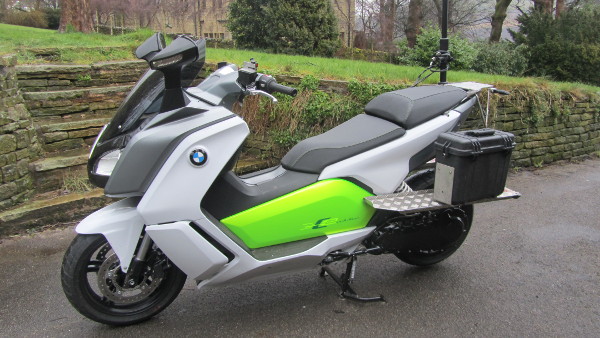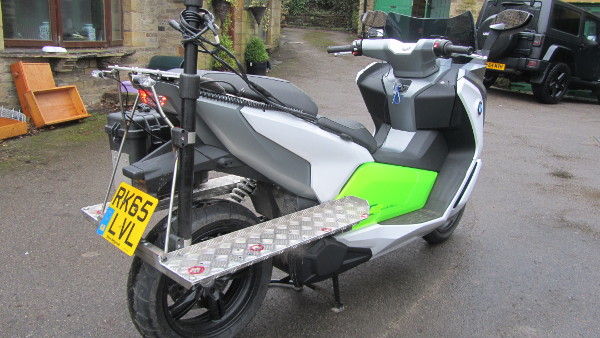Silent Movies
BMW electric scooters to be used when filming road-race events
John Newman
Once upon a time in the small village of Kirmington, in north Lincolnshire, Graeme, a lad in his early teens, and his mates would spend their time riding their step-thru field bikes over farmers' fields and tracks, and making stunt ramps to test their nerves and skill.
He loved his motorcycling, but developed an interest in cycling too, and was a decent racer, winning the Yorkshire Championship. His Dad, Billy Holmes, achieved much acclaim in the cycle-racing world, and in the 60s won many championship races, including the Tour of Britain; known at the time as the Milk Race.
Some years later, another lad from Kirmington, the son of Mr and Mrs Martin, rode the same fields and tracks, constructing similar stunt ramps to test himself; he, later in life, liked to ride cycles too - his name is Guy, but that's another (well-known) story that has been told elsewhere.
In the '80s, Graeme Holmes rode fast motorcycles: the likes of Suzuki GSXRs and Honda RC30s. Along with friends, he'd ride across Europe to big races and gatherings such as the Bol d'Or, in southern France. In 1990, he was approached by the organisers of the Tour of Britain and asked to carry a photographer/cameraman for live broadcast from the pillion space of a motorcycle.

photo by Penarth Daily News
This type of coverage was at an early stage of development, but Graeme had the cycling experience and knew the sport well; he also had the motorcycle expertise to respond to how riders react on the road in the various race situations. As an example, he told me of how quickly breakaways develop in cycle road races, and the level of concentration and reaction required from the motorcycle pilot to respond and not obstruct.
From the mid-nineties to 2006, Graeme was the go-to man for this type of motorcycle film work across other kinds of sporting events as well as cycle racing, such as marathons and triathlons. His work took him all over the world, and he also worked on programmes such as Top Gear, tracking the cast's various exploits including Richard Hammond at speed on two wheels.
Now, along with co-riders Gareth Williams, an ex-motorcycle instructor, Rob Llewelyn, an ex-motorcycle racer, and three very experienced camera operators, they organise themselves as
TV Motos Europe. But, being in conjunction with Californian sister company, TV Motos International, they work across the globe.
Silent Running
I met with Graeme at his home in Yorkshire because he'd just acquired and converted two BMW C Evolution scooters for filming use; this is the first time anyone in this field of work had decided to use electric bikes. He also has two new BMW 1200 GS bikes that have been fitted with the platforms and carry racks needed for the safety and stability of his camera colleagues on the crowded and often manic road space that are a feature of cycle races.
These scooters are expensive pieces of kit to invest in; BMW quotes a starting price of £13,500. The specifications show power output at 48bhp, with decent acceleration times of 0-50kms in 2.7 seconds and 0-100kms in 6.2 seconds. Graeme and one of his camera colleagues, Graham Maunder, were very impressed with the way power was delivered smoothly and, of course, quietly when BMW arranged to let them loose on the bikes.
Range, always the issue with electric vehicles at this stage of development, is stated as 100kms 'in everyday riding', to quote BMW's specifications. This will prove more than adequate for marathons and triathlon events and for city centre cycle race series, but could be a problem on major stage races where the riders are on the road for many hours, and where the peloton can carry speeds up to 60kms an hour for considerable distances. Often, the camera bikes will be accelerating hard to cover and capture different groups of riders in breakaways - additional capacity can be gained through what is called 'recuperation'; battery recharging through braking and engine braking adds around 10-20% increase in the range.
Moving to electric power has advantages when riding close to athletes in not producing any emissions. The C Evolution is fitted with a selection of riding modes that will help the pilot and camera operator deliver steady feed to the outside broadcast monitor. For example, 'Sail' gives a coasting ride with hardly any engine braking, and 'Eco Pro' boosts range but cuts back on performance.
Silent running: good for sound engineers who would rather broadcast sounds related to the event rather than the noise of a motorcycle engine. Not so good as racing cyclists particularly will not be able to hear the bike. Graeme has purchased a couple of bolt-on warning horns to let competitors and team cars know they are closing or close by. Initially, because of the silent running issue, insurance was impossible to obtain. The company has located a policy but at a cost of five times more than its BMW 1200GS conventional motorcycles.
If you're first in the field you need to be prepared to ad-lib and introduce innovations. Graeme has boosted the radio frequency (RF) power the bike sends by fitting an auxiliary battery. The RF is the signal sent from a microwave mast on the rear of the bike to a circling aircraft or helicopter, which then transmits to the satellite dish atop the outside broadcast unit. The scooter's small battery, enough to power the lights and horn, does not deliver enough output for this.
The first UK broadcast outings for the scooters was the Sports Relief events at the Olympic Park in London. The risk assessment exercise and paperwork for this and similar events have become a major administrative task in recent years. It wasn't that long ago that this wasn't necessary; Graeme recalls a time when all that was required was a licence and the fact that you were a known and competent rider. In over 20 years of piloting bikes in the close company of fiercely competitive cycle racers - whom often attempt to use the bike for slipstreaming - and their team cars, he's never had a crash or incident.
Over the Easter weekend, TV Motos was on duty to broadcast running action from the Cardiff Half Marathon. The event was also used as the occasion to launch the new bikes along with BMW, who will no doubt be monitoring how its bikes perform in these working environments.





